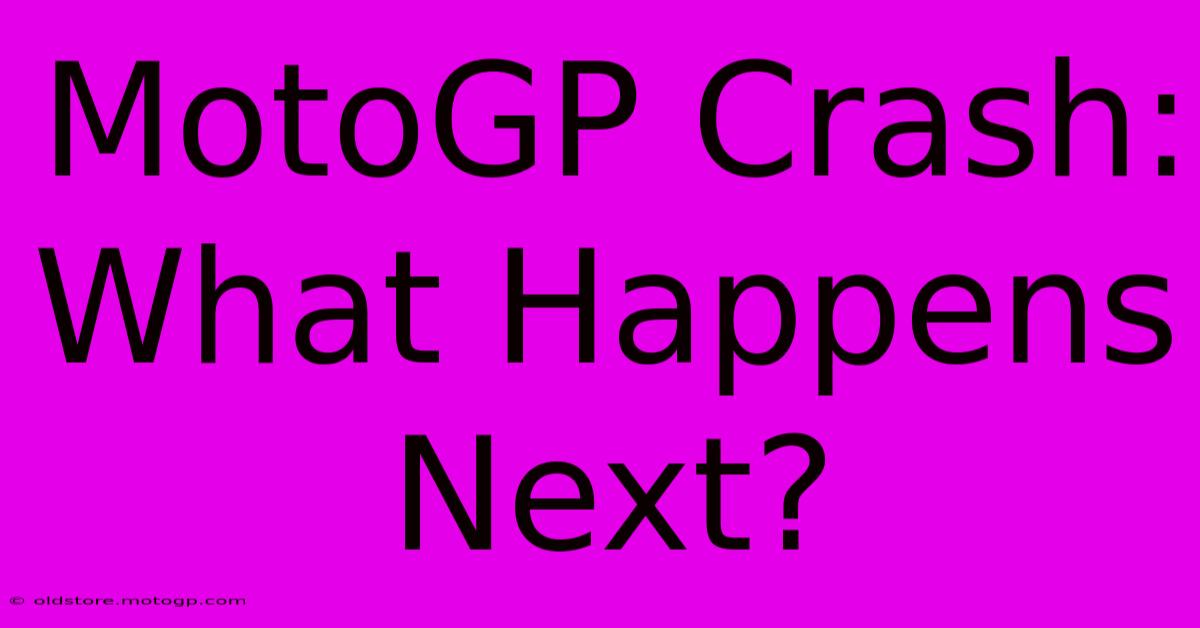MotoGP Crash: What Happens Next?

Table of Contents
MotoGP Crash: What Happens Next?
The roar of the engines, the blur of speed, the breathtaking overtakes – MotoGP is a spectacle of skill and daring. But inherent in the high-stakes world of Grand Prix motorcycle racing is the ever-present risk of crashes. When a rider goes down, the immediate aftermath is chaotic, but a carefully orchestrated process kicks into action. This article explores what happens after a MotoGP crash, from the initial response to the long-term recovery.
The Immediate Aftermath: A Symphony of Safety
A MotoGP crash isn't just about the rider; it's about the safety of everyone involved. The immediate response is a coordinated effort involving several key players:
1. The Marshals: First Responders on the Track
Highly trained marshals are strategically positioned around the circuit. Their immediate priority is to ensure the safety of the fallen rider and other competitors. They quickly wave yellow flags, signaling to other riders to slow down and proceed with caution. They then rush to the scene to:
- Assess the rider's condition: Checking for injuries and providing immediate first aid if needed.
- Clear the track: Removing the motorcycle and rider from the racing line to prevent further accidents.
- Signal medical personnel: Guiding the medical team to the precise location of the incident.
2. The Medical Team: Swift Action and Assessment
The MotoGP medical team is world-class, equipped to handle even the most serious injuries. Their swift response is crucial:
- On-track assessment: A rapid assessment of the rider's injuries, including a check for concussion, broken bones, and internal bleeding.
- Immediate stabilization: Providing essential medical care on the track, including administering oxygen and immobilizing injuries.
- Transport to the medical center: Quickly and safely transporting the rider to the circuit's medical center for further evaluation and treatment.
3. Race Direction: Controlling the Situation
Race direction plays a vital role in managing the overall situation:
- Red flag: If the crash is serious enough, race direction may red-flag the race, temporarily halting the competition to ensure the safety of all participants.
- Safety car: Less severe incidents may necessitate the deployment of a safety car, slowing the race down until the track is clear.
- Investigation: Race direction will investigate the cause of the crash, potentially leading to penalties or rule changes.
Beyond the Track: Diagnosis, Treatment, and Recovery
Once the rider reaches the medical center, a comprehensive assessment begins:
- Detailed examinations: Thorough medical examinations to determine the full extent of the injuries.
- Imaging and testing: Scans (X-rays, CT scans, MRI) and blood tests to identify any internal injuries or damage.
- Treatment and rehabilitation: Appropriate medical treatment, including surgery if necessary, followed by a tailored rehabilitation program.
Long-term recovery can vary greatly depending on the severity of the injuries. Some riders may return to racing relatively quickly, while others may face a prolonged period of recovery, even requiring career-ending decisions in severe cases. The support of medical professionals, team members, and family is crucial during this phase.
The Psychological Impact: A Silent Battle
It’s important to acknowledge the significant psychological impact a crash can have on a rider. Beyond the physical injuries, the emotional toll can be substantial:
- Fear and anxiety: The experience can leave riders with lingering fear and anxiety about future races.
- Post-traumatic stress: In some cases, severe crashes can lead to PTSD, requiring professional help.
- Mental health support: MotoGP provides access to mental health professionals to support riders through this challenging time.
Conclusion: Safety First in the World of Speed
MotoGP crashes are an unfortunate but inevitable part of the sport. However, the dedication to safety, from the marshals and medical teams to the race direction and ongoing research into rider protection, demonstrates a commitment to minimizing risk and supporting riders through every stage of a crash, from the initial impact to the long journey of recovery. The safety and well-being of the riders remains paramount.

Thank you for visiting our website wich cover about MotoGP Crash: What Happens Next?. We hope the information provided has been useful to you. Feel free to contact us if you have any questions or need further assistance. See you next time and dont miss to bookmark.
Featured Posts
-
F1 Qualifying Cota The Crowds Go Wild
Feb 25, 2025
-
The Precision Of Moto Gp Pictures That Showcase Skill
Feb 25, 2025
-
Experience The Power And Performance Of The Yamaha V4
Feb 25, 2025
-
Moto Gp Sprint Race Results Experience The Adrenaline Rush
Feb 25, 2025
-
Cota F1 General Admission The Heart Of The Action
Feb 25, 2025
